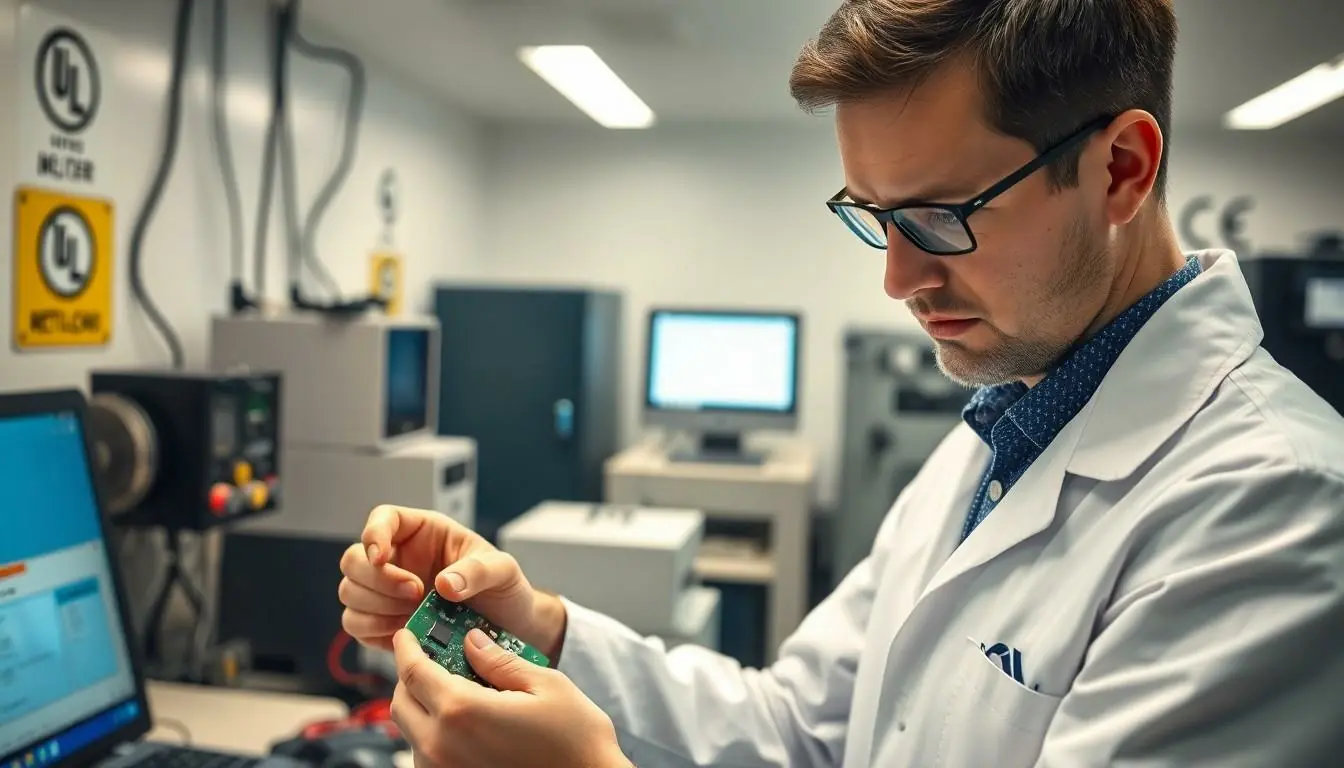In a world where gadgets seem to multiply faster than rabbits, understanding consumer electronics certification is more important than ever. It’s like having a VIP pass to the tech party, ensuring that every device you bring home meets safety and performance standards. Nobody wants to be that person who unknowingly buys a toaster that doubles as a fire hazard, right?
But don’t worry, this isn’t just a dry lecture on compliance. It’s a guide to navigating the electrifying realm of certifications that keep your devices buzzing safely. From UL to CE marks, these certifications can turn a confusing maze into a clear path. So buckle up and get ready to decode the labels that can save your sanity—and maybe even your home.
Table of Contents
ToggleOverview of Consumer Electronics Certification
Consumer electronics certification verifies that products meet specific safety, performance, and environmental standards. Certifications help consumers identify reliable and safe devices before making purchases. Various organizations conduct testing and certification, including Underwriters Laboratories (UL), the International Electrotechnical Commission (IEC), and the European Conformity (CE) mark.
UL certification ensures that products have undergone rigorous testing for safety risks. It covers categories such as electrical safety, fire hazards, and durability. The CE mark indicates compliance with European Union safety, health, and environmental regulations. Products with this mark can be marketed throughout the EU, reflecting adherence to established standards.
Certification processes vary among organizations, often depending on product type and regional regulations. These processes include thorough evaluations, testing, and audits for compliance. Manufacturers must provide detailed documentation to obtain certification and maintain compliance throughout their product lifecycle.
Regulatory standards encompass a wide range of categories such as energy efficiency, electromagnetic compatibility, and environmental sustainability. Meeting these standards not only enhances safety but may also lead to better marketability.
Understanding these certifications equips consumers to make informed choices about their electronics. Awareness of certification labels can prevent purchasing unsafe or ineffective products. By choosing certified devices, consumers contribute to a safer and more reliable electronics market.
Importance of Certification

Certification plays a vital role in ensuring consumer electronics meet necessary safety and performance standards. Understanding these certifications helps consumers make informed purchasing decisions.
Ensuring Product Quality
Product quality hinges on rigorous testing and adherence to established standards. Organizations like Underwriters Laboratories (UL) and the International Electrotechnical Commission (IEC) conduct evaluations to certify products. Each certification process involves extensive testing that identifies potential safety risks and performance issues. For instance, a UL-certified product undergoes thorough assessments to ensure it operates safely under specified conditions. Consumers benefit from these certifications, as they denote reliability and durability in electronic devices.
Building Consumer Trust
Trust is fundamental in consumer electronics. Certifications instill confidence in customers, indicating products have passed stringent safety criteria. A CE mark on a product assures buyers that it complies with European Union regulations. This assurance influences purchase decisions, driving consumers toward certified brands. Recognizable certifications serve as benchmarks for quality, helping consumers differentiate between products in a crowded marketplace. Ultimately, a robust certification process fosters positive relationships between manufacturers and consumers, promoting customer loyalty.
Common Certification Standards
Understanding common certification standards enhances consumer knowledge in selecting electronic devices. These certifications ensure products comply with specific safety and performance regulations.
FCC Certification
FCC certification confirms that electronics meet federal communication standards. It limits electromagnetic interference, ensuring devices don’t disrupt radio communications. Testing is conducted to evaluate compliance before products hit the market. Without FCC approval, devices cannot operate within the United States, making this certification crucial for manufacturers. Consumers benefit from increased reliability in wireless technology thanks to adherence to these standards.
CE Marking
The CE marking signifies compliance with European Union safety, health, and environmental protection requirements. Manufacturers must conduct assessments and document that their products adhere to EU directives. This mark allows free movement of goods within the EU market. Products bearing the CE mark inspire consumer confidence, indicating rigorous testing. Electronics without this certification may be denied entry to European markets, making it essential for international trade.
RoHS Compliance
RoHS compliance focuses on limiting hazardous substances in electronic products. This directive restricts materials like lead, mercury, and cadmium, promoting safer electronics. Manufacturers must verify that their products meet these standards during production. Consumer electronics featuring RoHS compliance are less harmful to the environment and human health. Awareness of these regulations helps consumers make safer, eco-friendly choices.
The Certification Process
The certification process encompasses several critical steps to ensure compliance with safety and performance standards.
Steps Involved
Certification begins with a comprehensive evaluation of the product. Testing follows, assessing safety risks, energy efficiency, and environmental impact. Manufacturers submit necessary documentation to certifying organizations at this stage. Third-party labs often handle testing to maintain objectivity. After successful testing, organizations like UL or CE issue certification marks. Certifications not only verify compliance but also provide consumers with the assurance of product safety. Manufacturers must regularly review and update documentation to maintain certification status throughout the product lifecycle.
Challenges Faced
Manufacturers encounter various challenges during the certification process. Obtaining and maintaining the necessary documentation can be complex and time-consuming. Meeting diverse certification requirements across different global markets adds to the difficulty. Products may face delays if they do not meet specific standards during testing. Additionally, staying updated with evolving regulations poses a challenge for many companies. Understanding the implications of failing certification can impact market entry and consumer trust. Ultimately, navigating these challenges requires diligence and a commitment to quality.
Future Trends in Consumer Electronics Certification
Emerging technologies are shaping the future of consumer electronics certification. Innovative testing methods, such as AI and machine learning, promise to enhance efficiency and accuracy in the certification process. Regulatory bodies are increasingly embracing digital solutions, streamlining documentation and compliance verification.
Changes in consumer preferences are also driving trends in product standards. A growing demand for environmentally sustainable products necessitates higher scrutiny of materials used in electronics. Certification standards will likely evolve to address these concerns, with initiatives focusing on eco-friendliness and reduced environmental impact.
Market dynamics are influencing certification practices. Globalization exposes manufacturers to diverse regulatory frameworks, prompting the need for more universal certifications. Collaboration among certification agencies will likely become more common, simplifying the certification landscape for global manufacturers.
Additionally, cybersecurity certifications are gaining traction in response to rising concerns about data security and privacy. Integrating cybersecurity standards into traditional product certifications will become essential for consumer trust. Manufacturers must navigate these evolving standards to enhance product credibility in the marketplace.
The Internet of Things (IoT) further complicates the certification landscape. With increased connectivity and data integration, certification agencies will need to develop new protocols for IoT devices. As smart devices proliferate, comprehensive certification practices will ensure safety and performance remain top priorities.
Finally, consumer awareness is rising as customers seek certified products that guarantee safety and reliability. Increased access to information allows consumers to make more informed purchasing decisions. Enhanced transparency in the certification process will build consumer confidence and drive demand for certified electronics.
Understanding consumer electronics certification is crucial for making informed purchasing decisions. As technology continues to advance, consumers must prioritize safety and reliability by seeking out certified products. Certifications like UL and CE not only ensure compliance with safety and performance standards but also foster trust between manufacturers and consumers.
With emerging trends in eco-friendliness and cybersecurity, the landscape of certifications is evolving. Staying informed about these changes will empower consumers to choose products that meet their needs while contributing to a safer and more sustainable market. Embracing the importance of certification ultimately leads to smarter choices in the ever-changing world of consumer electronics.





